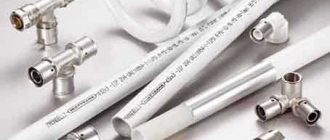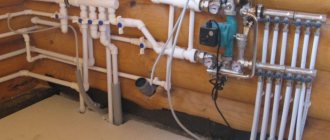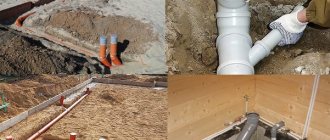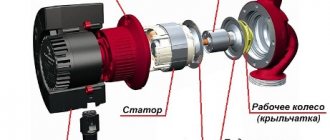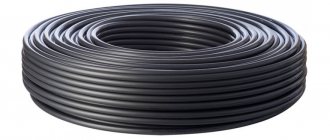How it works
It is a well-known fact that the soil temperature at a depth of about 1.5 m or more is constant throughout the year. Its value lies in the range of plus 5-7 ° C, and the temperature gradually increases with increasing depth. Thanks to this phenomenon, people store food and vegetables from their gardens in basements.
It turns out that the temperature there is always positive and it would be a sin not to use this heat from the ground to heat your home.
It is absolutely pointless to move such weak heat as +7 °C into rooms. The problem is not like this: we need energy, not temperature. And a regular air conditioner can help with this, only turned upside down. After all, what is he doing? In summer it takes energy from inside the building and moves it outside, and in winter it moves it in the opposite direction. This occurs due to heat exchange processes inside the refrigeration machine (Carnot cycle).
In short and in simple words, a liquid – coolant – circulates inside the air conditioner between two heat exchangers. In the first, it evaporates, taking heat from the air in the room, and in the second, it condenses, releasing it into the environment. The transition of the refrigerant from one state of aggregation to another is facilitated by 2 main units - the compressor and the expansion valve.
In the same way, the thermal energy of the earth is released. A coolant heated to a temperature of +7 °C moves along a contour of pipes placed deep in the soil. In the first heat exchanger, it meets the working fluid - freon, causing it to evaporate. In the second, freon condenses, transferring the resulting thermal energy to the heating system.
As a result of this movement, the earth cools by 2-3 °C, but the house warms up by 20-40 °C
You should not pay attention to the temperature discrepancy, because 10 times more liquid circulates in the earth circuit than in the heating circuit. Energy consumption is negligible; electricity is consumed to operate the compressor, pump and automation
In general, the ratio of energy consumption to energy extracted from the ground is approximately 1: 5–1: 7.
System installation
Geothermal heating of a country house at the stage of arrangement requires substantial financial investments. The high final cost of the system is largely due to the large volume of earthworks associated with the installation of the heating circuit.
Over time, the financial costs pay off, since the thermal energy used during the heating season is extracted from the depths of the earth with minimal energy consumption.
Installation of a horizontal heat exchanger for a geothermal heating system
- the main part should be located underground or at the bottom of a reservoir;
- In the house itself, only fairly compact equipment is installed and a radiator or underfloor heating circuit is laid. Equipment located inside the house allows you to regulate the heating level of the coolant.
What does geothermal equipment look like in a home?
When designing heating using ground heat, it is necessary to decide on the installation option of the working circuit and the type of collector.
There are two types of collectors
:
- Vertical - sinks into the ground several tens of meters. To do this, you need to drill a number of wells at a short distance from the house. The circuit is immersed into the wells (the most reliable option is cross-linked polyethylene pipes).
- Disadvantages: Large financial costs for drilling several wells in the ground with a depth of 50 meters.
Advantages: The underground location of the pipes at a depth where the soil temperature is stable ensures high efficiency of the system. In addition, the vertical collector occupies a small area of land.
- Horizontal. The use of such a collector is allowed in regions with warm and temperate climates, since the depth of soil freezing should not exceed 1.5 meters.
- Disadvantages: The need to use a large area of the site (the main disadvantage). After laying the circuit, this piece of land cannot be used for a garden or vegetable garden, since the system works by releasing cold when transporting the refrigerant, which will cause the plant roots to freeze.
Advantages: Cheaper earthworks, which you can even do yourself.
Horizontal and vertical collector type
Geothermal energy can be extracted by laying a horizontal geothermal circuit at the bottom of a frost-free reservoir. However, this is difficult to implement in practice: the reservoir may be located outside of private territory and then the installation of the heat exchanger will need to be approved. The distance from the heated object to the reservoir should be no more than 100 meters.
Why do you need to insulate pipes?
If you look at the map of freezing depths, you can see that in the northern regions it reaches 2.4 meters - naturally, digging holes of such depth on your site is too expensive. In addition, this is irrational from the point of view of supplying water from a well or well to the house; problems will arise with the well - the pressure pipe must come out of the head and in order to install pumping equipment it will be necessary to dig out and equip a caisson or a caisson pit of very great depth. Using insulation for water pipes in the ground, you can lay a water main at a shallow depth, saving money and increasing the ease of use and maintenance of pumping equipment.
Another advantage of insulating water pipes in the ground is saving resources. The water entering the house is heated for domestic needs and heating - it is clear that heating colder water will require more electricity. If the pipes are insulated from cold soil, then the costs of insulation and work will not only be fully recouped over time, but will also bring significant savings.
An effective way to combat freezing of water pipelines is to use an electric cable, which is glued to the line along its entire length and lowered into the well. Placing the cable and pipeline as additional insulation in a warm shell will significantly save energy when heating the water main.
Rice. 2 Table of heat losses depending on the thickness of the insulator
Operating principle of the heating system
People have always tried to get the heat emanating from the bowels of the earth. Thanks to the advent of geothermal heating, this became possible.
In the center of the earth there is magma, which warms the earth. Due to the presence of the top layer of soil, it does not cool. It was enough to learn how to use such heat to open an alternative source of heat. With its proper use, it will be possible to solve the problem of heat supply of any country houses.
Many people find the operating principle of a geothermal heat pump quite complex. In fact, it is enough to understand the features of heating from the ground. The operation of the system is possible due to the presence of an external circuit. performing the functions of a heat exchanger. It is located in water or underground. Inside this element there is water or any other liquid that absorbs heat. The coolant enters the geothermal pump, which accumulates heat. This equipment distributes the received energy throughout the entire internal circuit.
It is worth noting that such heat pumps correspond to standard sizes, but their performance turns out to be really high.
How to lay pipes underground: options and means
Laying a pipeline is a job that almost any owner of a summer house or country house faces. The fact is that ground installation of plumbing or heating is allowed only in undeveloped areas where the structure does not bother anyone or where it is not possible to place the system underground. In all other cases, underground installation is assumed.
Types of installations for ground heat extraction
The internal structure of the heat pump, briefly described above, remains unchanged in any case. But the design of the external circuit, which extracts energy from the ground, comes in two types:
- horizontal: a polymer pipe with a certain pitch is laid in a pit of the calculated size and depth of 1.5-2 m;
- vertical: circuit pipes are lowered into deep wells. Their number is also determined by calculation.
It is convenient to dig a pit at the stage of construction of a private house; this is done exactly in the place where the building is planned to be erected. Also, a horizontal contour can be arranged if there is a sufficiently large plot of land near the house. When there is no such area and there is very little space, the earth’s energy is collected by geothermal probes from deep wells. You will have to do several of them in different places.
The ends of the pipes from one or more external circuits are laid underground to the house and enter the basement of the building, where they are connected to the heat pump itself. The coolant flowing in underground coils is usually water or non-freezing liquid, depending on the region of construction.
In terms of the efficiency of obtaining energy from the earth, vertical contours are superior to horizontal ones, since they often pass through aquifers, and this improves the selection of heat. They also hold the lead in terms of installation cost, especially if wells are drilled in difficult conditions.
Rules for laying a heat supply pipeline in a ditch
A heat supply pipeline laid in the soil comes into contact with two media – the heat carrier and the soil. The parameters of the coolant (temperature, pressure) and its chemical composition (water, antifreeze) are known to the consumer in advance - from the parameters of the heating boiler or from the organization operating the heating main into which it is supposed to cut.
All that remains is to properly arrange the ditch if the trench option for installing the pipeline is selected. New technologies make it possible to lay pipes in the ground using a trenchless method, which has several options.
Digging a ditch for a heating pipeline
Important! at the beginning of the construction of a ditch, a permit for work with the land should be issued to the administration of the locality, to which a plan for the location of all highways will be attached so that there is no damage or accidents.
Work related to the ground for constructing a ditch begins with planning the area through which it will pass. If grading is not done in hilly areas, then the reliefs of the ditch and the site will coincide, the pipeline will be laid in waves and will be under the influence of preliminary stresses even before backfilling.
After completing the planning, they begin the axial marking of the ditch, which is done along a cord stretched over stakes driven into the soil.
The width of the ditch at the bottom for laying pipes with a diameter of up to 700 mm, according to SNiP 2.05.06-85 “Underground laying of pipelines”, is determined by the formula D (pipe size) + 300 mm. If the work is carried out manually, then deviation from this value is not scary - priority is given to the convenience of the work.
The second, more basic parameter is the depth of depth. The heating pipeline is laid in the soil below the frost mark, which depends on the region and is determined in a tabular manner. A fragment of a table from SNiP is given for clarity.
To calculate the depth of the pipe, add the size of the pipe plus another 50 cm to the desired value of the freezing depth. The calculation of the depth of the ditch is also carried out taking into account the characteristics of the soil of its lower part - if the base is clay, then it is leveled and compacted, after which the pipeline is laid. If the bottom of the ditch is sandy or contains large fragments of stone, then under the pipeline you need to make a cushion 5-7 cm thick from crushed stone of a fraction of 20-40 mm, on top of which a layer of clay of similar thickness is poured and compacted. This is done to prevent water from eroding the base under the pipe, the subsidence of which will lead to deformation of the pipeline.
In parallel with this work, an assessment is made of the soil removed during the excavation of the ditch - large rock inclusions are removed from it, which, after backfilling, can damage the walls of the pipe. Moreover, it is worth stocking up on the required amount of loose laying material for the pipeline as the first damping layer.
Important! If a ditch is installed during winter, then snow and ice are removed from it before laying the pipeline.
Heating pipeline installation process
To install a heat supply pipeline, steel pipes or polymer materials are used; their diameter is calculated depending on the heated area, the parameters of the heating equipment and the performance of the coolant.
The connection of the components of the heating pipeline is made depending on the material chosen for it - by welding or using connectors. The installation process begins in the direction from the building and is done in one of 2 ways:
- assemble the pipeline on the surface and then lower it into the ditch;
- carry out the installation process in a trench, lifting the extreme end of the pipe to the surface mark for connections with the next fragment, laying the joint on the base when ready.
Important! The height mark of the beginning of the heating supply pipeline must be less than the end point of the outlet (drain) section of the heating system pipe.
Thermal insulation of the pipeline
The pipeline is equipped with a heat insulator regardless of the pipe material. Thermal insulation makes it possible to reduce heat loss and the appearance of moisture in the middle of the pipe, and will also slow down the process of freezing of the system during unpredictable frosts if there is water in the circuit.
Important! Insulating the heat supply pipeline does not increase the temperature of the coolant, but only stops the freezing of the system for a certain period of time. Moreover, there is no insulating material with zero thermal conductivity that provides complete thermal insulation - the water in the circuit will still freeze without heat.
Requirements for heat insulation of pipes during installation of the system in the ground:
- low thermal conductivity;
- sufficient thermal stability - the ability to maintain its own characteristics in contact with the hot surface of the pipe;
- hydrophobicity – moisture resistance and waterproof properties;
- steam permeability - the ability to quickly dry out in case of emergency getting wet;
- biological inertness – resistance to bacteria;
- chemical resistance - inertness in relation to chemical compounds contained in the earth.
There are many types of materials for insulation, and the degree of compliance with their necessary requirements is different, so the solution to the question of how to insulate a heat pipeline must be decided in relation to specific operating conditions.
Insulation with mineral wool
Of the three types of mineral wool insulation material, two are suitable for insulating pipes in the ground:
- fiberglass wool;
- stone (basalt) wool.
At the same time, stone wool is better due to its low degree of hygroscopicity (the ability to collect moisture from the external environment) and low shrinkage.
It is better to use a material using foil, reinforced with firmware throughout the entire area (quilted), which is stronger and easier to work with. The heat insulator is placed with a layer of foil on the outside.
If the heating pipes are steel, then before insulation they are subjected to anti-corrosion treatment - the application of a protective paint coating, a high-quality and economical option of which is a solution of lead or red lead based on real drying oil.
For thermal insulation of heating pipelines with a diameter of up to 150 mm, it is good to use the linear method of laying min. cotton wool, when pieces cut to size are placed on top of the pipe and tied in a spiral with knitting wire, preventing significant compaction of the material. The longitudinal connection of the edges of the material for insulation is arranged from below with a one-on-one overlap of 10 cm, and the transverse connection is also overlapped.
To protect the insulation material from moisture, it is covered with roofing felt waterproofing in 1 layer, arranged using a similar technology.
In order for thermal insulation to perform its functions, it must be protected from damage, compaction under the weight of the soil, and additionally insulated from moisture. To do this, protective casings made of galvanized iron or fiberglass are fixed on top of the rolled roofing material. The longitudinal joint of the casing is made with an overlap of 2-3 cm and fastened with metal screws. Transverse joints of the casings are also arranged with overlap and tightening with clamps.
Treating the contact surfaces of longitudinal and transverse joints with bitumen-based mastic before joining creates an additional barrier to moisture from precipitation and perched water.
Schematically, the final result of thermal insulation of the heating pipeline looks like this:
Insulation with a shell made of mineral wool or artificial latex
Today's market offers much more practical materials for thermal insulation, the installation process of which is simple and the technical properties are higher. These are ready-made shells for a certain pipe diameter, called shells.
The mineral wool shell is a coupling with a longitudinal slot or two oblong coupling halves for installation on a pipeline with further fixation with crimp clamps. For shut-off valves and shaped pipeline components (expanders, tees, adapters), insulating shells of the appropriate combination are also taken into account.
Shells made of artificial latex (PPU), depending on the diameter, consist of two or three parts, placed on the pipe in a girth and connected by a locking system for making joints.
Both insulation materials are also produced in the form of ready-made multilayer shells, protected on the outside by a steel or fiberglass casing with transverse grooves on the edges for installing crimp clamps when connecting.
Important! The outer protective shell must not only be airtight, but also rigid enough to protect the insulation layer from compaction, which reduces its effectiveness several times.
The process of installing pipeline sections under the roadway
If the heating pipe of a personal home needs to be laid under a path where passenger vehicles travel, then it needs additional protection from vertical load.
In such a situation, a ditch of the required depth is dug across the path and a sleeve is placed in it on the prepared base (layout, cushion arrangement, compaction) - a profile pipe with a wall thickness of 5 mm. The heating pipe in this area is installed in the ground through this sleeve and with the internal structure of only thermal insulation - there is no need for galvanized steel casings. At the entrance to the sleeve and at the exit from it, foam plugs are made for installation to prevent moisture from penetrating into the sleeve.
The pipe in the sleeve does not have to have joints, since in the event of depressurization, access to them to make repairs will be difficult and time-consuming.
Important! If a protective sleeve is not used, and the pipeline material is a polymer material, then the depth of the pipe should be equal to the sum of the depth of soil freezing, one pipe diameter and another 1 m.
Construction of a geothermal heating system
Geothermy (the science of the thermal state of the Earth) has made possible the practical use of thermal energy that the earth's crust receives from the hot magma in the center of the planet.
A specially designed heat pump for heating a house is installed on the surface, and a heat exchanger is mounted in the ground or at the bottom of a reservoir. Thermal energy is “pumped out” to the surface and makes it possible to heat the coolant in the heating circuit of a house or non-residential facility.
How does the heating process occur?
Geothermal heating of a private home is a cost-effective option. If you use the earth's energy to heat a house, then for every kilowatt of electricity required to operate the equipment, there is from 4 to 6 kW of useful thermal energy obtained from the bowels of the planet.
In comparison with the operation of an air conditioner, we will see that when operating it, more than 1 kW of electricity is required to produce 1 kW of thermal energy. This is due to the inevitable losses in converting one energy into another, etc.
Heating a residential building using the thermal energy of the earth’s interior is very profitable, but the payback period for the equipment and installation costs will take some time.
Using the heat of the earth to heat a house does not require installing a traditional boiler to heat the coolant.
In this case, the system consists of three components
:
- heating circuit - geothermal source of thermal energy;
- heating circuit inside the house - low-temperature radiator or floor;
- pumping station - a heat pump for pumping thermal energy into a heating circuit from a heating circuit in the soil or under water.
Geothermal heating systems can also be used to heat greenhouses, outbuildings, swimming pool water, garden paths, etc.
Hidden heating pipes
Pros and cons of hidden gasket
The undoubted advantage of this method is that there is no need to fear that when designing the room, the heating pipes will not fit harmoniously into the interior.
Disadvantages of hidden installation:
- Labor intensity.
- The presence of heat loss, since even with high-quality pipe insulation, part of the heat is spent on heating the structure, which simultaneously performs protective and decorative functions.
- Difficulty of maintenance associated with the need to dismantle protective and decorative structures to access emergency areas;
- High price due to the need for more material.
Hidden installation of heating pipes in the floor is carried out before pouring the screed
Hidden heating pipe technology
Installation of heating pipes is carried out after installing all radiators on the walls. During finishing work, the original packaging of radiators is not removed.
Stages of work production:
- Preparation, including choosing the type of heating. To install a forced circulation system, it is best to lay heating pipes under the floor or in a wall structure. With natural circulation, the discharge pipe is placed behind the suspended ceiling, and the riser drains and the lower pipeline are laid in the wall.
- Pipeline markings made on walls.
- Execution of grooves. First, using a grinder, its boundaries are set, then the groove itself is knocked out with a puncher.
Laying heating pipes in a groove
- Wiring laying. The heating pipes are secured in the groove using clips.
- Connecting the pipeline to heating devices.
- Crimping is carried out, in accordance with current standards, under pressure.
- Decorating or walling up. Before starting work, the pipes must be insulated. Decoration can be done in the following ways:
- Plastering - sealing the groove with a low-strength solution of sand and cement or gypsum-based plaster.
- Heating pipes in the wall can be decorated with plasterboard. Strips of drywall are glued using gypsum plaster. The subsequent putty completely masks the groove.
- Boxes made of plasterboard, which do not require damaging the walls. They are used quite often, since their use eliminates the need to destroy the finish when problems occur.
Decorating the heating pipeline with a box
The sealing of the pipeline should only be carried out when the entire heating system is under pressure, which emulates its “behavior”. Making the necessary adjustments allows us to achieve minimal impact of deformation forces on the decorative finish.
In the previous article, we talked about installing heating in a wall and methods for attaching the circuit. Today we will talk about laying heating pipes in the floor. To understand the issue, you will need to find out which materials are better, whether reinforcement is important and what it affects. In addition to the characteristics of the materials, it is also necessary to understand the features of the hidden gasket. This applies to installing the circuit in a screed, under the floor, and even laying heating pipes in the ground.
The principle of operation of geothermal heating of a private house
To install geothermal heating, you will need the presence of such components as a circuit, reservoirs, equipment in the form of a pump, and a heat exchanger. It is worth noting that a power plant is not needed in this case. Heating from the bowels of the earth can, in its operating principle, resemble the operation of the most ordinary refrigerator, and the system itself continues to gain popularity every day.
The earth is heated by magma, which prevents it from freezing outside. The thermal energy obtained during the operation of the heating system is used for geothermal heating, for which a special heat pump is installed.
The operating principle here is special because:
- The pump is installed;
- Heat exchangers are installed inside the earthen shaft;
- Groundwater is connected to the pump through a water intake;
- The water heats up;
- Sent through the heat exchanger space.
This heating system has an important advantage and is that only 1 kW of electricity is required, and in return you can get energy in the range of 4-6 kW. For example, conventional air conditioners are not capable of converting even 1 kW of electricity into 1 kW of cold. By installing heating from the ground, you can recoup the investment in just a couple of years, however, provided that you have a competent approach to installation and selection of equipment.
Insulating materials for pipes
Modern industry has mastered the production of ready-made water pipes in an insulating shell, which is covered with a layer of waterproofing on top. When using piped water supply at home, in most cases you will have to do the insulation yourself, deciding how best to insulate the water pipe underground by choosing one of the methods below.
Sprayed insulation (PPU)
A method rarely used in everyday life consists of thermal insulation of a pipeline by spraying polyurethane onto its surface. The advantages of the method are that it provides 100% tightness and allows you to adjust the thickness of the fill; the disadvantages include the very high cost of the material and the work performed.
In addition to polyurethane, the insulating shell is made of liquid foam, the cost of which is lower than polyurethane spraying.
Rice. 5 Thermal insulation by spraying polyurethane and foam
Thermal insulation paint
One of the high-tech products, it is a thick acrylic-based mass containing the smallest particles of perlite, fiberglass, foam glass and glass-ceramic microgranules with a vacuum and a thermal conductivity of 0.00083 W/(m*K), providing basic thermal insulation.
Rice. 6 Thermal insulation of water supply pipes with paint
Typically, paint is applied to the surface in a layer of up to 4 mm, replacing insulation with a thickness of several tens of millimeters. Thermal insulation paint is supplied in special containers, has the form of a white or gray paste, which can be tinted; to thermally insulate sections or the entire pipeline, it is applied with a brush or by spraying. The advantages of using thermal insulation paint are:
- High degree of adhesiveness, allowing paint to be applied to steel and plastic surfaces with good adhesion.
- Possibility of effective operation in a wide temperature range from -70 to +260 C.
- Insulating a water pipe in the ground with paint reliably protects it from corrosion - this is a big advantage when using steel water pipes on a site.
- The material has a long service life, reaching up to 15 years; the possibility of painting it in various colors allows you to use paint on open pipes indoors, choosing a color that does not disturb the interior.
- According to the manufacturer, heat-insulating paint has the lowest thermal conductivity coefficient of all insulation, equal to 0.0012 W/(m*K). Air has a thermal conductivity of 0.023 – 0.026 W/(m*K). Some experts accuse the manufacturer of deceiving the consumer and indicate other figures in their calculations - 0.0698 W./(m.*K.).
Advantages and disadvantages
The objective advantages of geothermal heating can be considered:
- excellent efficiency;
- a solid service life (a heat pump lasts 2-3 decades, and geological probes last up to 100 years);
- stability of operation under almost any conditions;
- lack of connection to energy resources;
- complete autonomy.
There is one major problem preventing geothermal heating from becoming a truly widespread solution. This, as reviews from the owners show, is the high price of the structure being created. To heat an ordinary house of 200 square meters. m (not so rare), it will be necessary to build a turnkey system for 1 million rubles, up to 1/3 of this amount costs a heat pump. Automated installations are very convenient, and if everything is configured correctly, they can work for years without human intervention. Everything depends only on the availability of free funds. Another disadvantage is the dependence on the power supply of the pump unit.
Sequence of work
Heat supply from underground sources must be created according to a strictly developed algorithm. Since water and air systems have limited use, most practically used options involve drilling wells. And this is another reason why you can’t do everything yourself. Only special equipment allows you to penetrate to a depth of 20-100 m, where the necessary conditions for heating are created. Plastic pipes designed for a pressure of about 6 bar can be used as probes.
To increase the efficiency of the system, they use piping of 3 or 4 lines, the end sections of which are connected in the form of the letter U. Heating along the contour is very important, thanks to it it prevents cracking of pipes in severe frost. This heating is carried out through a wire stretched into the center of the channel through which current is supplied. If it is not possible to use energy piles, horizontal receivers have to be used. A platform with dimensions of 15x15 m is prepared for them, the soil is removed from it to a depth of 0.5 m.
This entire area is needed for laying some kind of probes. Electrical mats or pipes that exchange heat are often used. To increase the efficiency of the heating system, pipes are laid out in a spiral or in the form of a “snake”. It is impossible to say for sure which is better - ready-made complexes produced in series, or self-assembly. In the first case, the compatibility problem is automatically solved, but in the second, flexibility increases and the potential for modernization increases (although more attention must be paid to design).
Amateur builders can move away from a standard heat accumulator by replacing it with a concrete screed. Geothermal heating in such a system allows you to do without significant temperature fluctuations. You can conduct experiments with different coolants, as well as install compressors with varying performance. By properly calculating the loads and correctly distributing heat across the consuming circuits, you can make the system 15-20% more efficient. At the same time, power costs are noticeably reduced.
Horizontally placed pipes are laid to a depth of 50-300 cm. To keep the area of the lines as small as possible, they are made in the form of turns. But between two separate lines there must be at least 200 mm. Any construction work must be preceded by a determination of the thermal output of the soil. If it is less than 20 W per 1 sq. m, there is no point in a geothermal circuit. To ensure the drainage of groundwater, the bottom of the pits is covered with a layer of sand. Pipes based on cross-linked polyethylene perform well.
INFRARED RADIERS WITH YOUR HANDS
Heat sources - infrared emitters, called eco-heaters - are another option for heating rooms in a private home, office or factory. The operating principle of an infrared emitter is based on the transfer of thermal energy in the form of infrared radiation to objects that, when heated, release directed heat into the air of the room, into the surrounding space in open areas, etc.
The most effective IR emitters, as alternative heating systems, are capable of heating specific objects or parts of premises. Thus, an IR emitter can heat people working outdoors or in a specific part of the room. The use of IR heaters creates savings on heating, allowing you to heat only the useful part of the space. According to the method of installation and fastening, heaters differ in wall, ceiling, floor, and with directed action of infrared radiation.
Pipe insulation
Additional insulation will increase the performance of the system, and will also serve as external protection for the pipe. This can significantly increase service life. And for this, the selected material must have the necessary characteristics.
Expanded polystyrene shell for pipe insulation Source baurum.ru
Basic requirements for insulation:
- Fairly low thermal conductivity.
- Resistance to temperature fluctuations.
- Good moisture absorption.
The easiest way is to use either thermal fiber or basalt wool. In the first case, the main advantage of the low-density material is somewhat reduced by the need for additional insulation. Cotton wool is very easy to work with and has excellent technical characteristics. But its cost is high.
Of the modern materials, polystyrene foam is the most popular. The insulator is produced in the form of a special shell, the installation of which can be easily handled by even a beginner. You can also fill the line with foam concrete. Or the water supply pipe in the ground is equipped with a special heating cable.
Independent organization of geothermal heating
As mentioned earlier, such a system is the most affordable, which means that every home owner can take advantage of the earth’s energy resources. At the same time, organizing geothermal heating will not require significant investments or human resources. Installing the system yourself is quite simple. In this case, the main thing is to perform the correct calculations.
Naturally, the installation of equipment and the heat pumps themselves depends on the selected type of heat exchanger.
- The easiest way to perform installation is on condition. that the house is located near a pond. In this case, it is enough to hire several assistants and special equipment to lay the pipe at the bottom. After this, all that remains is to connect the heat pump, after which the house will become warm.
- If you prefer a horizontal heat exchanger. then you will have to dig up the area. Subsequently, it will not be possible to organize a garden or vegetable garden here.
- The installation of a vertical heat exchanger is considered the most difficult. The performance of such work should be entrusted to specialists with relevant experience and professional drilling equipment.
In addition to laying the pipes, you need to pay attention to the installation of the heat pump itself. Such a device must be installed correctly, otherwise the system will be ineffective
Geothermal heating has only recently come into use. Thanks to him, it is possible to obtain cheap energy with a minimum of costs. For this alternative to be effective, all requirements must be taken into account and the heat pump must be installed correctly.
Insulation on the street
To insulate heating pipes outdoors, the possibility of contact with moisture must be taken into account. It could be rain or snow. Therefore, waterproofing must be provided. The standard method of insulating heating pipes on the street:
- a layer of mineral wool;
- winding with silk threads;
- layer of roofing material;
- winding made of metal wire, resistant to corrosion (galvanized or aluminum).
Do heating pipes need to be insulated? You have probably seen more than once the deplorable state of the insulating layer of heating mains in your city. This directly affects the temperature in apartments. For example, there is a temperature level of the supplied coolant determined by government regulations. Based on this value, the average temperature in residential premises and the cost of utilities are calculated.
Calculations are made taking into account the serviceability of all elements of the heating system, including the insulating layer of heating pipes passing from boiler rooms to houses. If there is insufficient thermal insulation in apartments, the temperature will be lower. It turns out that according to the documents everything is fine, but in fact, the standard is not met and, as always, there is no one to blame. And people have to pay in full, even though their home is far from Tashkent.
How Geothermal Systems Work
Operating principle of a heat pump. Click to enlarge.
Heating using the heat of the earth is no longer a myth, but a common practice.
Geothermal heating systems can operate on the principle of physically transferring thermal energy from the environment to a refrigerant.
A similar process is observed in the operation of a conventional refrigerator.
More than 75% of the total volume of heat that can be released during the operation of a system that heats a house with the heat of the earth is environmental energy.
Subsequently, it accumulates and then enters the living rooms and other rooms of the cottage or country house.
Experts point out that this type of energy has an amazing ability to self-heal, so the geothermal heating system does absolutely no harm or damage to the energy or ecological balance of the environment and our planet
The heating system has one important advantage - it is absolutely safe to use
The heating system has one important advantage - it is absolutely safe to use
Equipment that won't take up much space.
Heating a private house with the heat of the earth began to be actively introduced quite recently. Experts call the main reason for the emergence of such heating systems for private homes energy crises, which often appeared in the 70s of the 20th century.
At first, heating with earth's energy was considered a luxury, so only the richest and most elite families could afford a completely innovative home heating system.
Further, due to the active development of science, technology and the emergence of completely new technologies, geothermal heating systems became increasingly widespread, and the cost of their installation and maintenance decreased.
The heat pump takes up very little space in your home. Click to enlarge.
Today, a small family, even with an average income, can afford to install a system for heating their home without seriously disrupting their family budget. Modern geothermal equipment has been qualitatively improved and modernized.
Improvements to systems continue to this day, as the creation of new units leads to reduced energy consumption and greater savings.
Such heating systems operate at a qualitatively new level, because new and unusual fuel, such as earth energy, is used for air conditioning and heating a private home.
After all, it is precisely this energy that can create cozy, comfortable and optimal conditions for the life of every person, and does not pollute the environment with harmful and negative substances, as happens during the combustion of peat, coal or gas.
Geothermal heating can easily operate without any combustion processes, so owners do not have to worry about the issue of fire and explosion of the system, it is completely safe to use.
Underground heating installation
In some cases, it is necessary to lay heating pipes in the ground, for example, when the boiler room is some distance from the heated room. Before laying heating pipes underground, you will have to solve two problems at once:
A layer of soil and everything that is on the surface presses on a pipe laid on the ground. Therefore, in order to protect the system, sleeves are used. A PVC sewer pipe with a diameter of 110 mm is perfect for this purpose.
Before laying heating pipes underground in a sleeve, they must be insulated, despite the fact that the system is laid below the freezing level of the soil. The heat loss is still significant. For insulation, mineral wool or foam covers are used. In addition, pipes are produced that have a layer of foam insulation and a protective plastic shell. They are specifically designed for underground installation.
Operating principle of alternative heating
If you are familiar with how an air conditioner or refrigerator works, then the similarity of these processes with the principle of operation of geothermal heating is obvious. The basis of the system is a heat pump, which is connected to two circuits - external and internal.
To organize a traditional heating system in any house, it is necessary to install pipes for transporting coolant and radiators, when heated, heat will flow into the premises. In our case, pipes and radiators are also needed. They form the internal contour of the system. Warm floors can be added to the scheme.
The external contour looks much larger than the internal one, although its dimensions can only be assessed during planning and installation. During operation, it is invisible because it is underground or underwater. Plain water or ethylene glycol-based antifreeze circulates inside this circuit, which is much preferable.
The geothermal heating system includes two circuits - internal and external, as well as the heart of the heating system - a heat pump, which, by compressing the coolant, increases its temperature
The coolant in the external circuit is heated to the state of the medium in which it is immersed and is sent in a “heated” form to the heat pump. Through it, concentrated heat is transferred to the internal circuit, as a result of which the water in pipes, radiators and heated floors is heated.
Thus, the key element that animates the entire system is the heat pump. If your home has an ordinary washing machine, then know: this pump will take up approximately the same area. To operate, it needs electricity, but, consuming only 1 kW, it produces 4-5 kW of heat. And this is not a miracle, since the source of “additional” energy is known - this is the environment.
Types by type of construction
Geothermal heating in a cottage works on a principle somewhat similar to a refrigerator. The main element here is a heat pump, which is switched on in two circuits simultaneously. The internal circuit is a traditional heating system consisting of piping and radiators. And the external one is a large heat exchanger, which is placed either under the water column or underground.
Typically, a liquid containing antifreeze circulates inside the heat exchanger. This kind of coolant takes on the temperature regime of the environment, which subsequently, already heated, goes to the heat pump. The previously accumulated heat goes into the internal circuit, after which the water in the pipes and radiators is heated.
Components of a geothermal heating system
Thus, turnkey geothermal heating of a house includes one most important element in the system - a heat pump. This is a compact device that takes up little space.
Needless to say, installation of such a system will also be expensive. Therefore, many owners of private and country houses decide to heat their private houses with the heat of the earth themselves.
First of all, it is necessary to take into account that there are three types of heat exchangers - horizontal, vertical and water-based.
Horizontal heat exchanger. This type is used quite often. When using it, pipes are placed in specially made trenches to a depth that is slightly higher than the freezing level of the soil cover in the area. However, this system has one drawback - it requires a large area to place the collector, and not everyone can afford such a design. And if there are trees on your territory, then the equipment should be placed at a distance of approximately 1.5 meters from them.
Geothermal heating system with horizontal heat exchanger
Vertical heat exchanger. Such a device is more compact, but at the same time more expensive. In order to equip your home with geothermal heating with such a device, you do not need a large area, but you will need drilling equipment. Indeed, in this case, the depth of the well must necessarily be from 50 to 200 meters. Note that this is the most expensive method, but it can last as long as 100 years! If you want to geoheat a house located outside the city, then the system is suitable. And the landscape remains untouched.
Geothermal heating system with vertical heat exchanger
Water-based heat exchanger. This type is the most economical, as it uses the heat of water. It is recommended to install the system at a distance from a body of water no more than 100 meters. The pipeline contour is laid on the bottom in the form of a spiral, and the depth should be no more than 3 meters. As for the reservoir, it is recommended that its area be at least 200 square meters. With such a system, labor-intensive work and permission are not required.
Ground to water heat pump
Thus, it can be noted that making geothermal heating of a country house yourself is quite difficult. However, you can implement your plan with at least one assistant. The third method is the best option, but there are several necessary points without which it will not work, and in particular, a pond.
Types of heat insulators
Below are the main materials for thermal insulation of communications:
Thorough insulation of heating pipes
To insulate outdoor heating pipes, special mineral wool is used. Mineral wool for heating pipes comes in several types:
- Basalt – made from rock with a high basalt content. A special feature of this insulation is its high resistance to heat; the operating temperature reaches 650 degrees Celsius. Basalt wool does not react with chemical compounds and does not emit toxic substances when heated.
- Fiberglass - the main component is quartz sand. It is used not only in its pure form. Glass is made from sand, which is also part of this insulation. This material can only be used for insulating external pipes, since their operating temperature is less than two hundred degrees, about 180.
The disadvantage of such insulation of heating pipes is the tendency of the material to absorb moisture, which negates all its thermal insulation characteristics. How to insulate outdoor heating pipes to avoid mineral wool getting wet? It is for this purpose that waterproofing is used in tandem with basalt or glass wool.
It should prevent contact of the insulation with moisture, since insulation of heating pipes on the street is possible due to the porous structure of the wool. And when the air cavities are filled with water, the temperature of the coolant is transferred to the air through the best conductor, water. Therefore, it is extremely important to protect the insulation layer from moisture.
The easiest way is to wrap the insulated line with roofing material, which can be secured with wire. Cheap and cheerful, but a method proven by many years of practice. In this case, any waterproof material that is sufficiently resistant to mechanical stress can be used as waterproofing;
- Styrofoam.
For communications, special forms are made that repeat their geometry. Typically, this is a ring consisting of two parts. Each part has a groove connection, which creates an additional barrier against moisture.
Polystyrene foam almost does not absorb moisture, and this “almost” may cause problems, since heating pipes in the ground must be insulated with absolutely moisture-proof materials.
Although there is a special type of polystyrene foam called “extruded”. It is denser than regular foam and completely waterproof.
This group of insulation materials also includes polyurethane foam. They are close in composition. Such materials can be either individual insulation elements or parts of a single structure of a multilayer heating pipe. It is also possible to apply the above-mentioned compositions in liquid form. To do this, special compressors are used, with the help of which the insulation is sprayed onto the working surface. In this case, the advantage is the complete tightness of the insulating layer;
- foam insulation for heating pipes.
These are products in the form of a cover. The materials used are: rubber, polystyrene foam or polyurethane. Their internal diameter coincides with the standard dimensions of heating circuits. In order to put on such a cover, a longitudinal cut is provided, which is subsequently glued together. To do this, a special adhesive is applied to the end of the cut;
- reflective winding of heating pipes.
Penofol - reflective insulation
The name speaks for itself. The idea is to reflect warm currents thanks to the mirror surface of the insulation. Aluminum foil is used for this. It is wound over the main insulation and secured with metal wire or clamps. Insulation for heating pipes with foil performs several functions simultaneously:
- reflects warm currents back to the circuit;
- keeps the cold out;
- protects from wind and moisture.
Foil is also used in tandem with foamed polyethylene or polyurethane. For example, penofol, which consists of a synthetic layer of foam insulation and a layer of foil glued to it. It is produced in rolls of different widths and is used not only for insulating communications, but also to create a “thermos” effect when insulating rooms;
A fairly new type of insulation. It was first used for space modules. The designers were faced with the task of creating an effective heat insulator with minimal weight, since when launching spaceships and satellites, every gram matters. A few millimeters of such paint is enough to replace a thicker layer of other insulation. It is widely used for insulation of heating mains.
Do it yourself: what and how
If you are going to install geothermal heating yourself, then it is better to buy the external circuit ready-made. Of course, we are only considering ways to horizontally position the external heat exchanger: under the surface of the soil or under water. It is much more difficult to install a vertical well collector yourself if you do not have the equipment and drilling skills.
A heat pump is not a very large piece of equipment. It will not take up much space in your home. After all, in size it is comparable, for example, to a conventional solid fuel boiler. Connecting the internal circuit of your home to it is not a difficult task. In fact, everything is done in exactly the same way as when organizing heating using traditional heat sources. The main difficulty is the design of the external circuit.
This arrangement of the house relative to the pond is more common. The main thing is that the reservoir is no further than 100 meters from the cottage
The best option would be to use a reservoir if one is found within a distance of no more than 100 meters. It is necessary that its area exceed 200 square meters, and its depth - 3 meters, which constitute the average freezing parameter. If this body of water does not belong to you, then obtaining permission to use it may become a problem.
If the reservoir is a pond that is on your property, then the matter becomes simpler. The water from the pond can be temporarily pumped out. Then work on its bottom can be done easily: you will need to lay the pipes in a spiral, securing them in this position. Excavation work will only be needed to dig a trench, which will be needed to connect the external circuit to the heat pump.
After all work has been completed, the pond can be filled with water again. In the next hundred years, the external heat exchanger should work properly and not cause trouble to its owner.
If you have at your disposal a plot of land on which you just have to build housing and grow a garden, it makes sense to plan a horizontal ground-type heat exchanger. To do this, you should make a preliminary calculation of the area of the future collector, based on the parameters already indicated above: 250-300 square meters of collector per 100 sq. m. meters of heated area of the house.
How to insulate a water pipe in the ground with your own hands
When choosing how to insulate a water pipe on a site, they take into account the material of its manufacture, the outer diameter, the cost of the insulation and the complexity of the installation work.
Rice. 11 Calculation of the thickness of the pipe heat insulator
Installation of insulation
Typically, low-pressure polyethylene pipes (HDPE) with a diameter of 1 inch are used to supply water for individual water supply; installation of the insulation shell is carried out in the following way:
- Install a shell made of glass wool, mineral wool or polystyrene foam, polyethylene foam, fixing it with adhesive tape. When installing mineral or glass wool, it is necessary to ensure the tightness of the joints - otherwise water will get into the joint and the wool will saturate it, and the thermal insulation properties of the insulation will be significantly reduced.
- After installation, the soft heat insulator can be protected from compression by the soil with a more durable material; usually they use roofing felt, wrapping it around the shell several times and securing it with tape. The advantage of its use is hydrophobicity, which protects the insulation from moisture absorption.
- The insulated pipeline is lowered into the channel and covered with a light granular composition to reduce pressure; expanded clay is usually used.
It is clear that installation of foam insulation, in contrast to low-density types, is much simpler, and it does not place high demands on the tightness of joints.
It should be taken into account that the installation of plastic segments must be carried out by fastening them to each other with a slight shift of 20 cm, like an overlap connection.
Fig. 12 Insulation of a plastic water pipe in the ground with a foam shell
Cabling
Installation of an electrical cable will cost more, but the depth of the pipeline is minimal. The heating wire can be located inside or outside the pipeline; water pipes are commercially available with an installed electrical cable or with a cable channel for its installation. Most often, cable installation is used on the surface, while the depth of the pipeline does not exceed 50 cm. Installation of a cable heater consists of the following stages:
- The pipeline at the location of the cable (in a spiral or straight line) is covered with foil adhesive tape.
- The electrical cable is laid on the glued tape and secured with the same adhesive tape.
- A shell of basalt insulation is installed on top of the resulting structure, which is connected with tape. When installing a heating cable along a line, it is practical to use foam insulation with special grooves.
- To monitor the operation of the system, it is advisable to install temperature sensors along the water supply line.
Rice. 13 How to insulate a water pipe underground with an electrical cable
When deciding how best to insulate a water pipe in the ground with your own hands, many people prefer a foam shell - it is easy to install, has better physical parameters and is low in cost. It is more practical to use an electric cable when the water pipes and well head are shallow - it can be used to simultaneously heat the water in the main and the well.
Types of geothermal heating at home
Geothermal heating scheme
Before doing geothermal heating of a country house with your own hands, you should carry out a number of preliminary measures. First of all, find the optimal way to arrange the primary circuit pipes.
The main condition for this is the temperature of the environment where the lines will be located. It should not be lower than +7°C. In practice, this involves installing pipelines into the ground. In some cases, the main environment may be a pond or river. However, reviews of geothermal heating for this type of home often indicate low efficiency in winter.
To properly organize alternative heat supply, you must perform the following steps:
Calculate the optimal power. If geothermal heating of a private house will be the main one, its rated power should ensure heating of the air in the entire building.
Conduct an analysis of the soil composition and the depth of its freezing. The choice of layout of the primary circuit pipes depends on this.
Determine the location of the heat pump. To minimize heat losses, do-it-yourself geothermal heating systems are installed in a separate room - a basement or outbuilding.
It is important that the temperature in it is not lower than +14°C.
Failure to follow these simple rules may result in system malfunction
Often reviews from geothermal heating owners indicate the importance of initial analysis and selection of the right equipment
With horizontal placement
Horizontal outline
The least labor-intensive method of installing primary circuit pipes is horizontal. They are located at a depth of 0.5 to 3 m. To reduce the area of the highway, they are arranged in turns. But at the same time, the distance to each should be at least 20 cm.
Before making geothermal heating, a primary analysis of the soil condition is carried out. First, its heat transfer is determined. It can range from 20 to W/m². Based on this, the total length of the primary circuit is calculated.
In addition, you should perform the following steps:
- Checking the level of soil freezing. The depth of the pipes should be below this indicator;
- Groundwater. To remove them naturally during periods of large floods, a sand layer is poured onto the bottom of the pit;
- Selection of pipeline material. It must be sufficiently flexible and mechanically reliable. For geothermal heating in Europe, cross-linked polyethylene pipes are most often used.
With vertical pipelines
Vertical work scheme
Taking into account the basic principles of operation of geothermal heating of a house, during design it is necessary to achieve maximum heating of the coolant from the ground. This can only be done when installing vertical lines.
To organize vertical-type geothermal heating of a country house with your own hands, you need to make wells with a depth of 30 to 100 m. The primary circuit pipelines are placed in them.
This scheme is more labor-intensive than the vertical one, but has a number of advantages:
- Great depth of highways. In this case, the heat transfer to the environment increases by 25-30% - up to 70 W/m²;
- Small area for installation;
- There is virtually no dependence on soil freezing.
In addition to this method, the basic principles of geothermal heating are often used for hot water supply in the summer. To do this, the primary circuit is placed in water - a lake or river.
Before drilling wells, it is necessary to do a soil analysis and determine the optimal depth. The composition of the soil will directly affect the complexity of the process.
Secrets of proper insulation of water pipes
A warm pipe can become an attractive habitat for rodents.
To prevent them from chewing through layers of materials, you can:
- wrap the pipes with metal mesh;
- plaster with concrete mixture with broken glass;
- wear a metal sleeve.
It will be useful to draw up a diagram of the underground part of the pipeline and save it in case of repair work. It is best to insulate pipes in the summer, when the groundwater level drops and the ground is dry and warm.
Organization of geothermal heating
Installation of a horizontal geothermal heating circuit
Consumers still have the main question - is it possible to use earth energy as the main source of heating for a country house? This is possible, but only with a professional approach at all stages - from calculation to installation and testing of the system.
First of all, you need to choose the right heat pump. Considering their high cost, you should first perform all preliminary calculations of its characteristics. Only in this case will heating using the thermal energy of the earth have maximum efficiency. Among the reliable manufacturers are Buderus, Vaillant and Veissman. The average cost of a heat pump for heating from the depths of the earth is about 360 thousand rubles with a rated power of 6 kW. More productive models can cost over 1 million rubles.
In addition to the cost, you need to pay attention to the material used to make the pipes. To minimize heat losses in heating from the thermal energy of the earth, it is recommended to use the following:
- Cross-linked polyethylene. It is characterized by low cost - optimal for horizontal schemes;
- Stainless steel pipe. It is used in heating using the thermal energy of the earth with a vertical arrangement of the external circuit. It compares favorably with cross-linked polyethylene due to its high thermal conductivity and mechanical strength. The disadvantage is the high cost.
For optimization, it is recommended to install external and internal temperature sensors, as well as a heat accumulator. This will minimize the cost of heating a private house using earth energy.
An example of installing geothermal heating in a private house can be found by watching the video:


